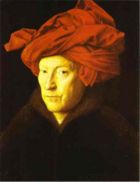Jan van Eyck
Jan van Eyck (Maaseik ca. 1390 - Brugge 1441) was a Flemish painter. Van Eyck is considered to be a founder of the Early Renaissance style in the Northern Renaissance. His works were mostly portraits and religious subjects. His masterpiece was the altarpiece in the cathedral at Ghent, the Adoration of the Lamb (1432, St. Bavon, Ghent, Belgium).
His best portraits are Portrait of Cardinal Nicola Albergati (c.1432), Portrait of a Young Man (1432), Man in a Red Turban (1433), which is probably a self-portrait, Portrait of Margaret van Eyck, Artist's Wife(?) (1439) and also one of the masterpieces of the Western world Giovanni Arnolfini and His Wife Giovanna Cenami (The Arnolfini Marriage) (1434). Among his other best works are Madonna from the Inn's Hall (1433), The Lucca Madonna (1436), The Madonna of Canon van der Paele (1436), The Virgin and Child in a Church (central section of a portable altar) (1437), The Virgin and Child with Saints and Donor (1441). [1]




